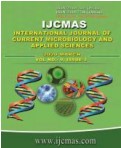


 National Academy of Agricultural Sciences (NAAS)
National Academy of Agricultural Sciences (NAAS)

|
PRINT ISSN : 2319-7692
Online ISSN : 2319-7706 Issues : 12 per year Publisher : Excellent Publishers Email : editorijcmas@gmail.com / submit@ijcmas.com Editor-in-chief: Dr.M.Prakash Index Copernicus ICV 2018: 95.39 NAAS RATING 2020: 5.38 |
Tomato is widely consumed vegetable in the world. It is used as raw and processed form. Tomato flowers are self as well as controlled pollinated. The crop has more than thirteen species including cultivated and wild types with huge diversity and is susceptible to diverse stress conditions. Recent advances in the biotic and abiotic stress in tomato transcriptomics have been reviewed here. Transcriptome is a particular set of RNA expressed during a stress, developmental stages or a condition in a group of cells. Transcriptomics is a promising technology for understanding molecular interactions during disease, interpretation of functional elements and molecular constituents of cell. Transcriptomics allows indexing all transcripted species such as mRNA & small RNA; to determine gene structure: start site, 5’and 3’ends, transcriptional modification, splicing patterns; and to quantify differential gene expression in stress condition. There are many techniques of transcriptomics such as RNA sequencing, Microarray, EST and SAGE. Transcriptomics by RNASeq is frequently used system as being cost effective. Sample preparation is a critical step for sequencing procedure. High quality RNA is essential. As transcriptomics yield huge amount of datasets, bioinformatics tools are required for proper data analysis. Gene ontology is obtained as molecular function, cellular components and biological processes. Panel of genes such as WRKY and phenyl propanoid were found to be expressing during stresses in tomato. Evaluation of differentially expressed genes paves the way for candidate gene selection. These genes may be focussed in constructive breeding programs. Researchers recommend the reference tomato genome enrichment and bioinformatics workforce surge.
 |
 |
 |
 |
 |